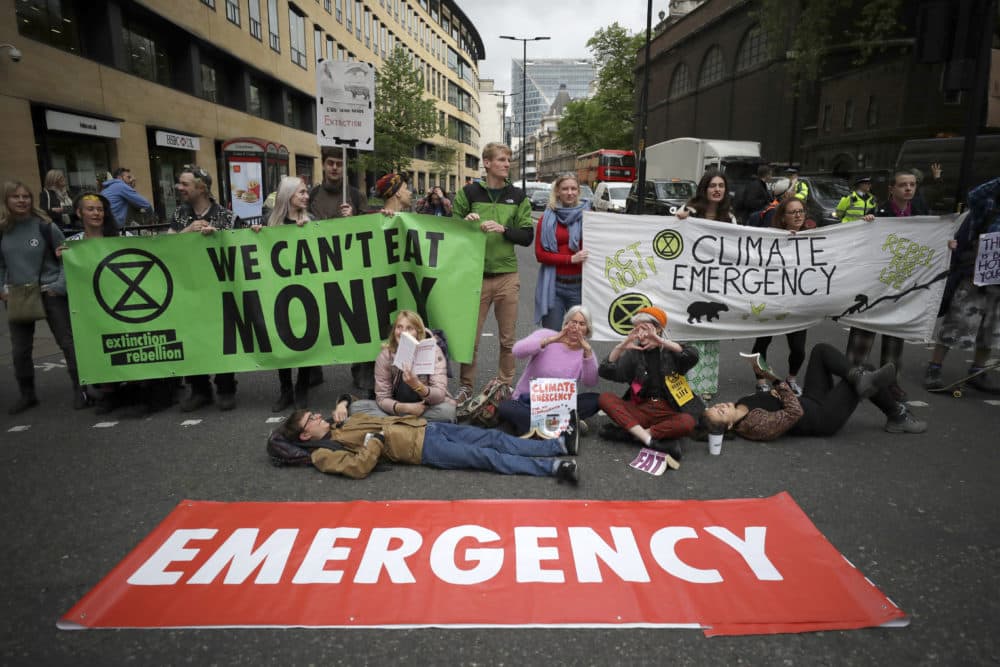Advertisement
Commentary
The Challenge Of Covering Our 'Uninhabitable Earth'

A few weeks ago, about 100 climate change protesters showed up at the Boston Globe, declaring that “media outlets have not reflected the climate crisis with sufficient urgency or effectively communicated its full impacts on human life.” Their action came during a week in which members of Extinction Rebellion staged massive protests and “die-ins” throughout Europe, Australia and New Zealand.
In choosing this name for their movement, these protestors are not being histrionic. They’re being realistic. Just this week the U.N. released the summary of a comprehensive biodiversity report that determined humans are hastening the extinction of 1 million plants and animals.
But with few exceptions (most notably Chris Hayes on MSNBC), the mainstream and “liberal” television media are failing climate activists miserably in their inadequate coverage of not just the protests, but the scope of the crisis that’s given rise to them. Indeed, according to one study, the four major broadcast networks spent a combined total of just 142 minutes on climate change coverage last year.
I get it. Global warming is not “breaking news,” even if the video-friendly storms and floods and climate migrants it generates are. In fact, Chris Hayes was honest enough to tweet last July that climate coverage was a “palpable ratings killer.”
More than carnage, more than tragedy, hopelessness and despair do indeed cause us to turn away. If accelerating climate change is presented as unstoppable and its effect irredeemably catastrophic — if fighting it is portrayed as futile — then flight is the natural human response. Rightly or wrongly, David Wallace-Wells, author of “The Uninhabitable Earth,” faced considerable criticism two years ago when the precursor to his book (a piece in New York magazine of the same name) was considered by some to be overly alarmist; for painting a picture of the future so dire as to be paralyzing.
Alas, some of his predictions, recently believed to be catastrophizing, are gaining more evidentiary weight. But, as futurist author Alex Steffen observes, “Optimism is a political act; cynicism is obedience.”
So how should the press alert people to the accelerating train that has already left the station? Not through neglect, and not through sensationalizing either. As long as the media treat climate change purely as a standalone political topic — subsumed under the endless yack-yack about who is rising and falling in the polls — ignorance, inaction and division will persist.
Advertisement
The media must treat climate change as the pervasive challenge infusing every aspect of life, with its impact evident on every beat.
But it doesn’t have to be this way. We can learn from the past how to cover and educate the public about the emerging future. For example, reporters covered the Great Recession in 2007-2008 not purely as an electoral issue, but took care to examine its impact on housing, employment, tax revenues, physical and mental health and the need for government regulation.
The media must treat climate change as the pervasive challenge infusing every aspect of life, with its impact evident on every beat. After all, it drives immigration crises, droughts, floods, economic instability, technology developments and public health challenges currently presented as standalone issues.
They have to do it by mustering not just the increasingly ineluctable facts, but by employing the art of storytelling, marrying fact with narrative. Some scientists maintain that, “… storytelling could be an evolutionary mechanism that helped keep our ancestors alive.” It just may be the human activity that will do the same for our children.
Richard Powers magnificent Pulitzer Prize-winning novel, "The Overstory," makes trees the foundational characters, helping us see them not as the backdrop to human activity, but as both the enabler and victim of it. Nathaniel Rich’s heartbreaking, infuriating and enlightening contribution to the New York Times Magazine, “Losing Earth: The Decade We Almost Stopped Climate Change” (which is also now a book) draws power from its portraits of the individuals who read and screamed the writing on the wall.
While it is essential to inform the public about rising sea levels, it is the image of the desperate family huddled on the roof of their house, or the story of a migrant immigrant whose once-thriving farm has turned to dust that excites our empathy and moves us to action.
That’s not to say that coverage should consist solely of stories of suffering. Author Naomi Klein and Alexandria Ocasio-Cortez — the congresswoman with an extraordinary gift for conveying complex ideas in simple, accessible terms — have given us an example to emulate in a “Message from the Future,” a video that not only explains policy but suggests action.
Alex Steffen argues that, “… realism ought best to be defined as ‘within our capacity’ and ‘necessary in light of our planetary crisis.’” If the media is to fulfill their mission of presenting what is real, that means they must reveal both what is necessary and what is possible. When municipalities like St. Petersburg, Florida, commit to 100% renewable energy and the government of Scotland sets a target of zero net-emissions by 2045, we get a sense of what political will married with good science can accomplish.
And take heart, broadcasters: As the swift, remarkable growth of groups like Extinction Rebellion and the Sunrise Movement build public awareness, stories about these positive examples of functional government may even get higher ratings.

